Diet as the Way to Lose Weight
- Many people want to lose weight.
- Every person has their reasons.
- The issue of weight loss is relevant, but requires careful monitoring.
Often, many people think about losing extra weight. Every person has their reasons for doing so – one wants to lead a healthier life, while others want to attract people. One way or another, the questions of weight loss are acute for humanity; for this reason, quite often among the already known classic methods of weight loss new and radical options that can aggravate human health appear. In order to prevent unnecessary health issues and achieve the desired effect, nutritionists offer patients to use the rules of the popular ketogenic diet.

Everything New is Actually Well-forgotten Old
- In the early twentieth century, ketogenic diet was used to treat epilepsy.
- Carbohydrate deficiency in the diet caused insulin reduction.
- With the advent of drugs, the diet has been relegated to the background.
- It was only thirty years ago that nutritionists rediscovered the ketogenic diet.
Recently, ketogenic diets have been used by a large number of young and adult people, and this method of starvation has become incredibly popular. However, if one looks at the historical context of ketogenic diets, it is clear that the diet has a rather long and mixed history. This diet was first introduced in the early 20th century to treat diseases of the nervous system, particularly epilepsy (Rho 5). A prerequisite for the appearance of the diet was the use of fasting: when food ceased to arrive, insulin stopped being produced in the body, significantly affecting the central nervous system (Rho 5). Such fasting was indeed valid, but it was impossible to use it for a long time. The situation was particularly difficult for children, as deprivation of food posed a serious health hazard (Rho 6). At that time, a diet similar to healing fasting was developed, but it gave the body energy from fats. It showed excellent results – people with epilepsy practically stopped having seizures. Indeed, the success of the ketogenic diet was not celebrated for long: soon, there were specially developed drugs, as a result of which the diet was forgotten for some time. It was only in the 1990s, when the problem of non-universal antiepileptic drugs for patients matured, that such a diet became discussed again. Information about ketogenic diets started to spread in the media, and the “new” weight-loss remedy began to be popularized.
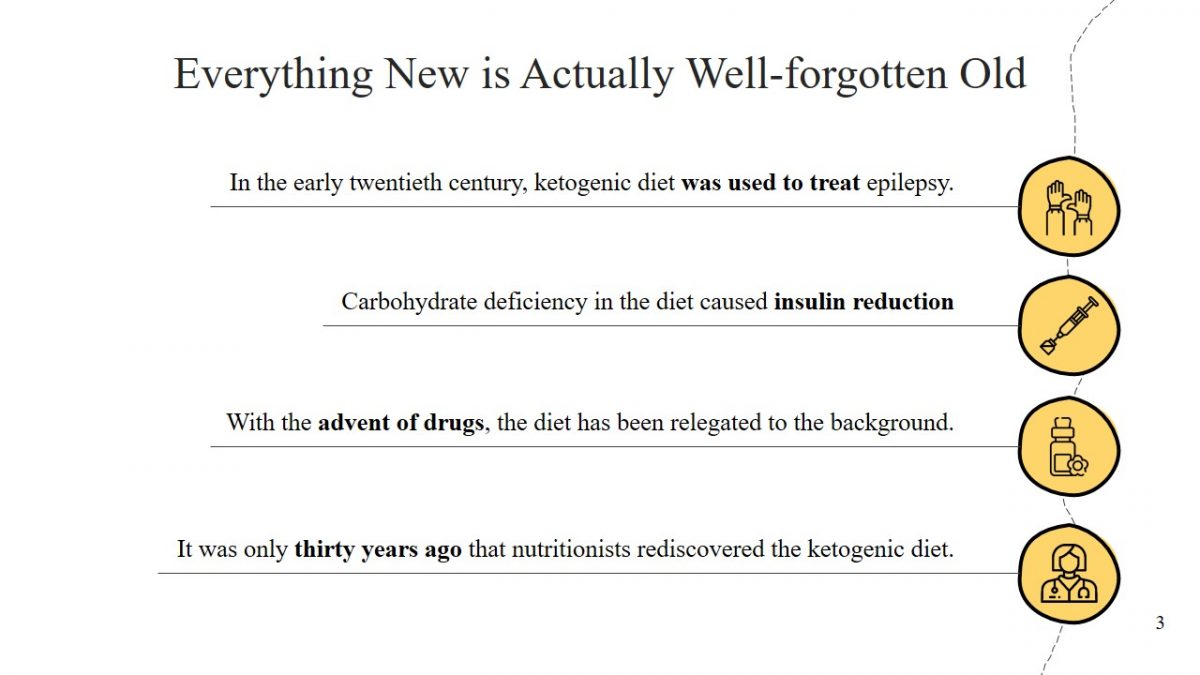
The Mechanism of the Diet
The rule is simple: lack of carbohydrates leads to burning of fats. The body draws energy from burning its own deposits or with food – as a result, the body weight is reduced.
The meaning of the ketogenic diet is that when carbohydrates are stopped when glucose concentration in blood decreases, the body searches for other sources of energy and burns fat. This process involves both fats from food and the body’s supplies. In the reorganization of diet, the liver produces ketone bodies (acetoacetate), which participate in the oxidation of fatty acids and are used as energy by many organs, including the brain. This condition is called ketosis (Yancy, Mitchell, & Westman 1734). As glucose disappears from the blood, the production of insulin, a hormone that prevents fat burning, is reduced.
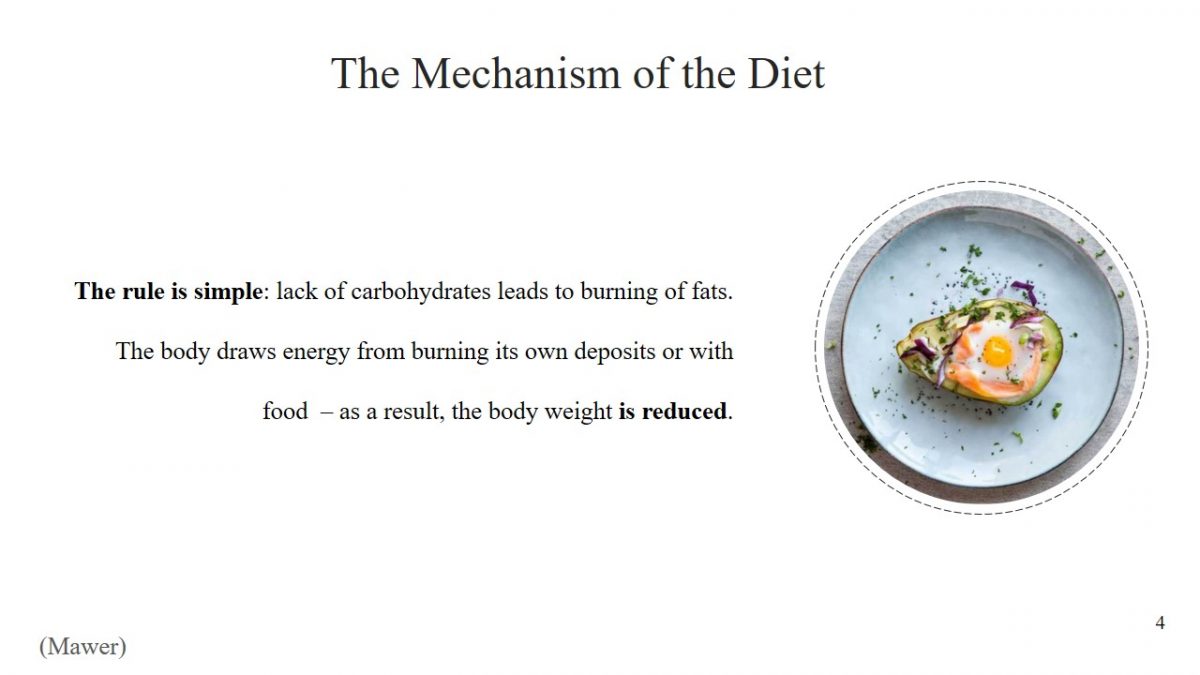
Scientific Evidence
- There are many scientific proofs of the optimality of this model.
- Zajac et al. confirmed the short-term effect of the diet on athletes.
- Carbohydrate elimination strengthens muscles, normalizes the biochemical composition and helps to quickly lose weight.
The decision to use any diet must be meaningful, and the effectiveness of starvation has been scientifically proven. For example, Zajac et al. found that a ketogenic diet has a positive effect on the performance of athletes (2496). The study determined what changes would result from changing diets to predominantly fatty young cyclists. Scientists concluded that the short-term effect of a ketogenic diet could preserve muscle structures in athletes after exercise, reduce body weight, and improve biochemical composition. An incredible achievement of Zajac et al. is the discovery that a ketogenic diet has a positive effect on a person’s breathing ability (2498).

Who is Ketogenic Diet Good for
- Meat lovers;
- Those who want to save muscle mass;
- Patients with diabetes mellitus.
Despite the complexity of the first days and strict diet restrictions, for some people’s ketogenic diets are ideal. It is worth trying out for the following categories of people who want to lose weight:
- Meat lovers. Many diets offer a drastic reduction in meat-eating or complete rejection, but a ketogenic diet does not restrict it.
- Those who want to save muscle mass. Normally diets can reduce muscle mass, but a ketogenic diet does not destroy muscle fiber structures, which is more suitable for professional athletes.
- Patients with diabetes mellitus. Ketosis can control blood sugar levels (Yancy, Mitchell, & Westman 1734). It is a type of professional diet, so a doctor’s consultation is necessary.
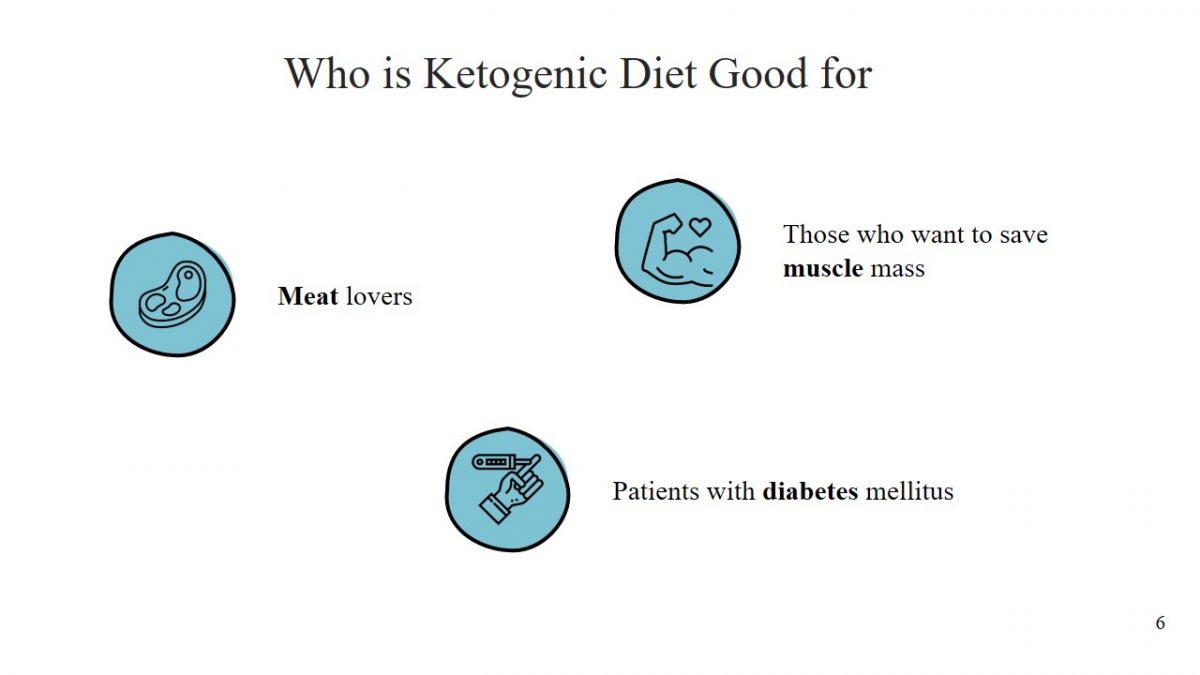
Mistakes that are Made
Lack of education can lead to:
- Carbohydrate consumption.
- Consumption of large quantities of proteins.
Due to their lack of education, beginners often make typical mistakes when using a ketogenic diet. Most of these errors will neutralize the positive effects of the diet, but others can have adverse effects on health. The most common mistake is when a person neglects the basic rule of diet and eats small amounts of carbohydrates. However, it is essential to understand that even a slice of eaten bread delays the start of ketosis. The second error is the opposite: people often completely give up carbohydrates, but in addition, they increase the amount of protein they consume. Protein poisoning leads to the destruction of the liver, kidneys, and digestive system problems.
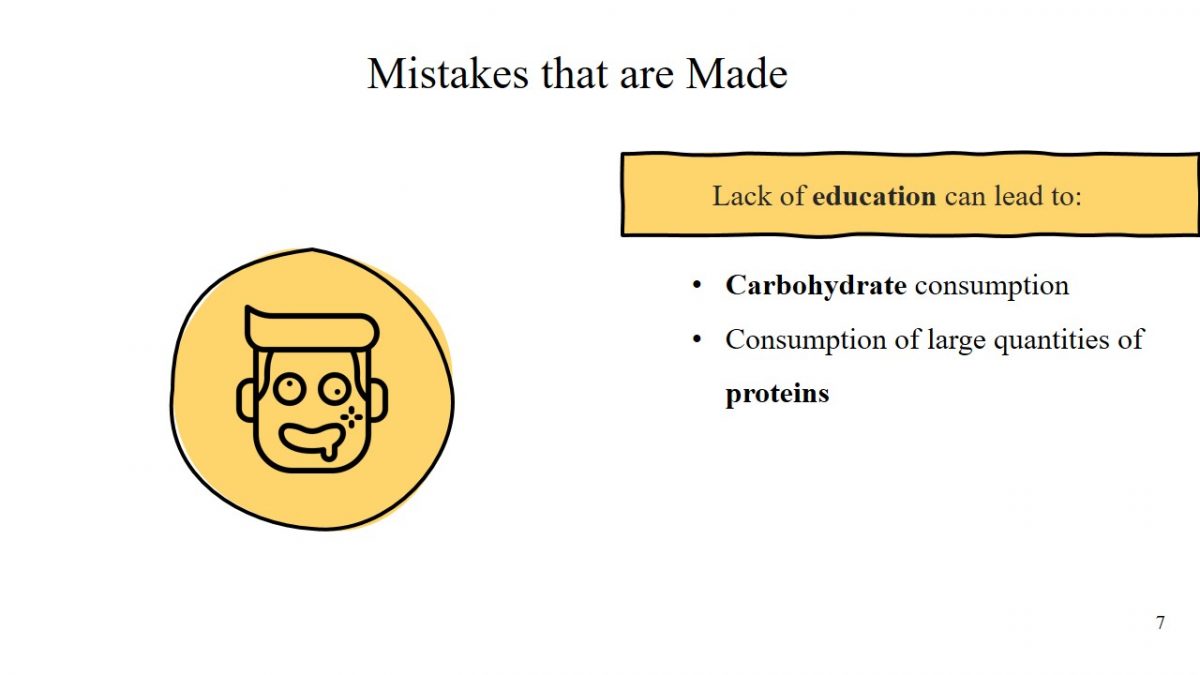
Basic Diet
The most challenging part of the keto diet is getting used to an entirely new way of eating, especially the rejection of most foods with high carbohydrate content and the addition of fat. Large amounts of natural fat can be found in vegetable and animal oils. Low-carbohydrate meat products may include beef, poultry and eggs, and fish. Non-starchy foods such as avocados, tomatoes, cabbage, and broccoli are allowed types of vegetables. On a ketogenic diet, it is possible to eat fruits and berries such as raspberries, kiwi, lemons, and blueberries.
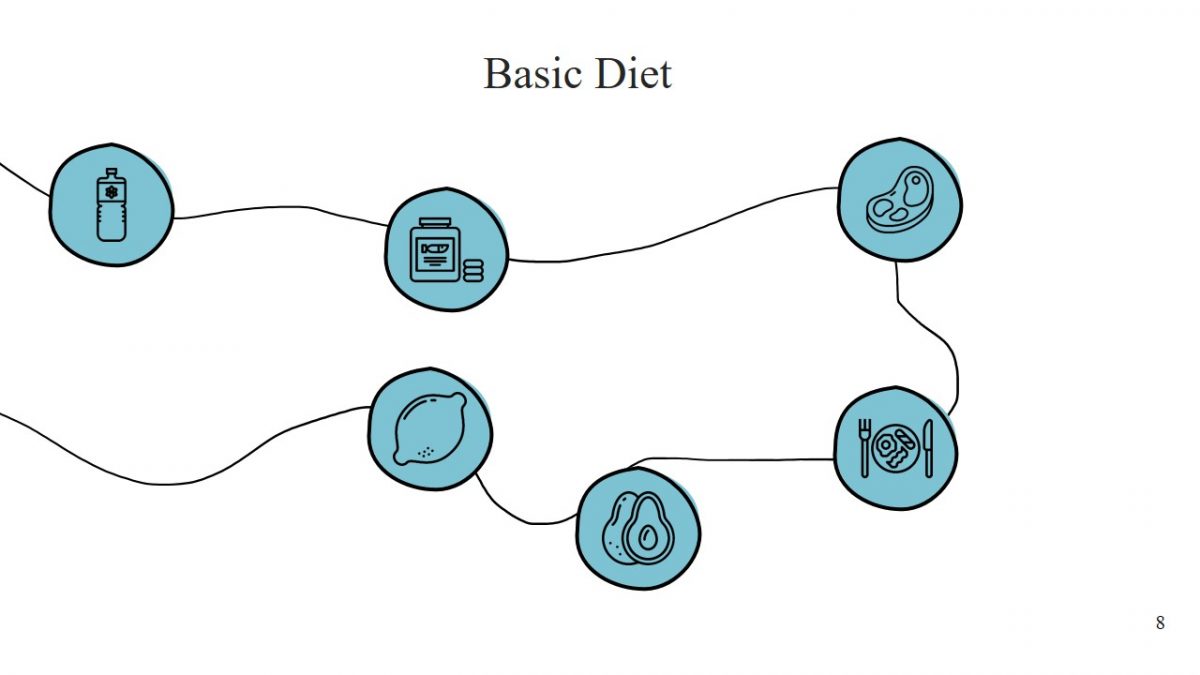
What Does a Person Get: Arguments “For”
- The scientific validity of diet.
- Rapidity of fat burning.
- Comfortable process.
- Long-term result.
- Cholesterol Control.
- Reducing epileptic seizures.
- Improving skin condition.
Those who decide to use ketogenic diet rules for weight loss should understand the benefits that await them. First, the effectiveness of such a diet has been scientifically proven (Zajac et al. 2493). Secondly, with such a diet, a person burns excess fat very quickly. Also, unlike other diets, the patient has no sense of hunger, so fasting is comfortable. Also, it should be noted that the result obtained is quite long term as the person is not hungry, and the body is not stressed. Several scientific studies demonstrate that a ketogenic diet improves cholesterol levels (“Pros and Cons” 1). This reduces the likelihood of cardiovascular disease. In addition, it should be remembered that a diet is right for people with epilepsy – the number of seizures and convulsions decreases (Feldman 36). In the world of cosmetology, there is a belief that a ketogenic diet has a positive effect on skin health by inhibiting the growth of acne and pimples (Feldman 36).
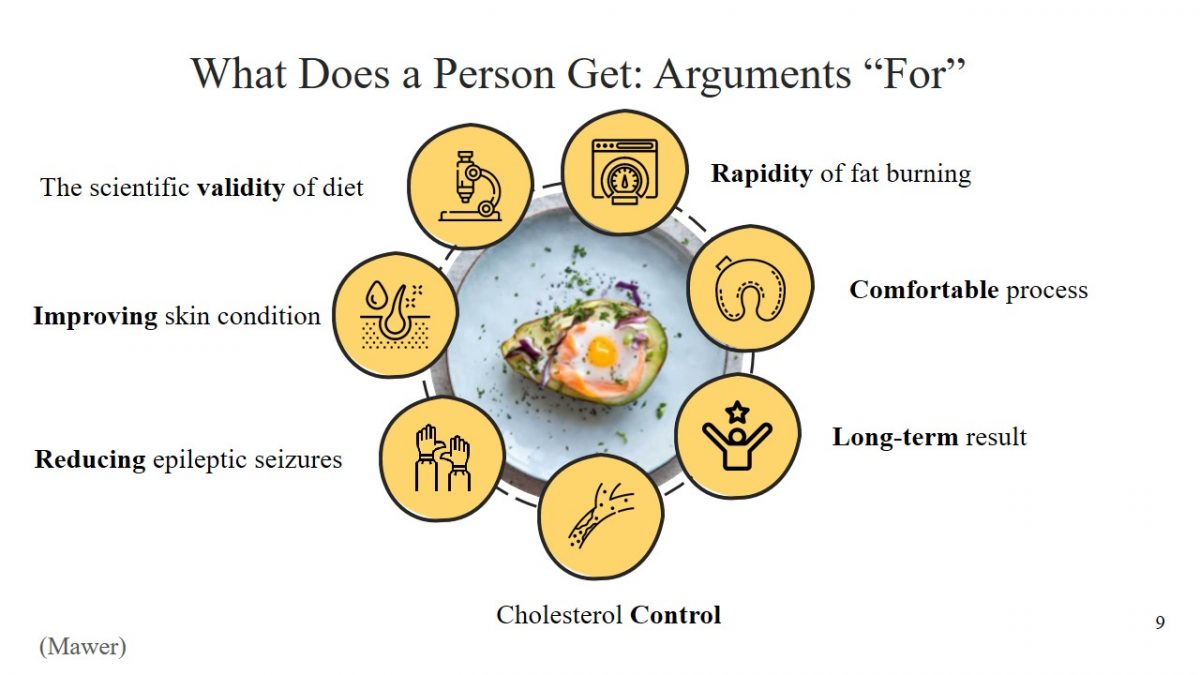
What a Person will Face: Arguments “Against”
- This diet is unbalanced
- Like any diet, it requires willpower.
- It is quite long, can be used for years.
- Side effects are possible.
It is essential to understand that there are no ideal weight loss models. A ketogenic diet is rich in deficiencies that can significantly worsen a person’s condition (Pros and Cons” 2). For this reason, it is necessary to consult a nutritionist before using such a diet.
- First, it should be noted that the ketogenic diet is unbalanced – it excludes the intake of several nutrients, vitamins, and trace elements.
- Secondly, it requires motivation and responsibility – one has to give up favorite dishes and regularly calculate the number of calories.
- The third disadvantage of the diet is duration: a ketogenic diet can last from 3-4 weeks to a year. There is no point in staying on a diet for less than three weeks because, during this time, the body will go through ketogenic adaptation and only begin to get all the benefits of this diet.
- It also has many side effects: constipation, nausea and vomiting, growth disorders, kidney stones, and changes in blood lipids.
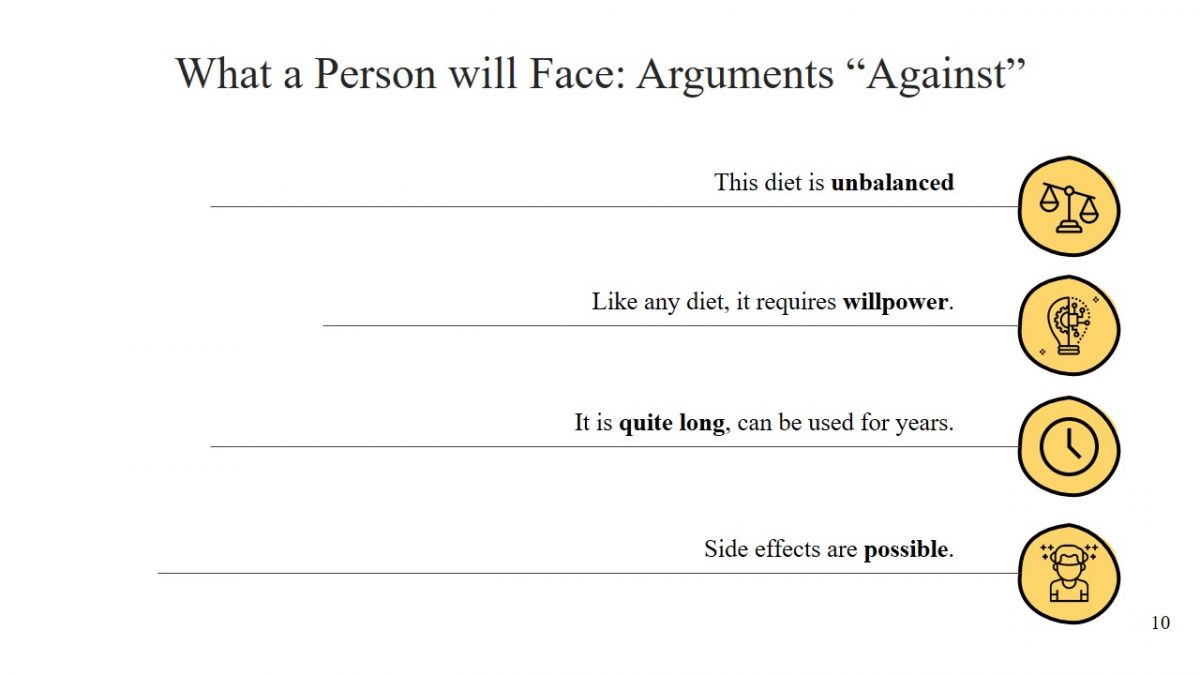
What Else Should be Mentioned
What must besaidis:
- This diet is not suitable for pregnant and sick patients.
- Long-term effects require careful consideration.
- Each diet is selected individually and requires analysis by a specialist.
The ketogenic diet has another disadvantage, which, however, cannot be unequivocally attributed to the general disadvantages. The fact is that this type of diet is not suitable for all population groups, and is contraindicated for medical reasons to pregnant women and people with kidney and liver diseases (Feldman 34). The effects of a long-term diet on healthy people have not yet been well understood. Dieticians are advised to choose a diet that can be sustained throughout life. Short-term effects may be successful, but the method is not suitable for everyone. Dietary recommendations are tailored to each individual and following the next trend without consulting a doctor is not recommended.
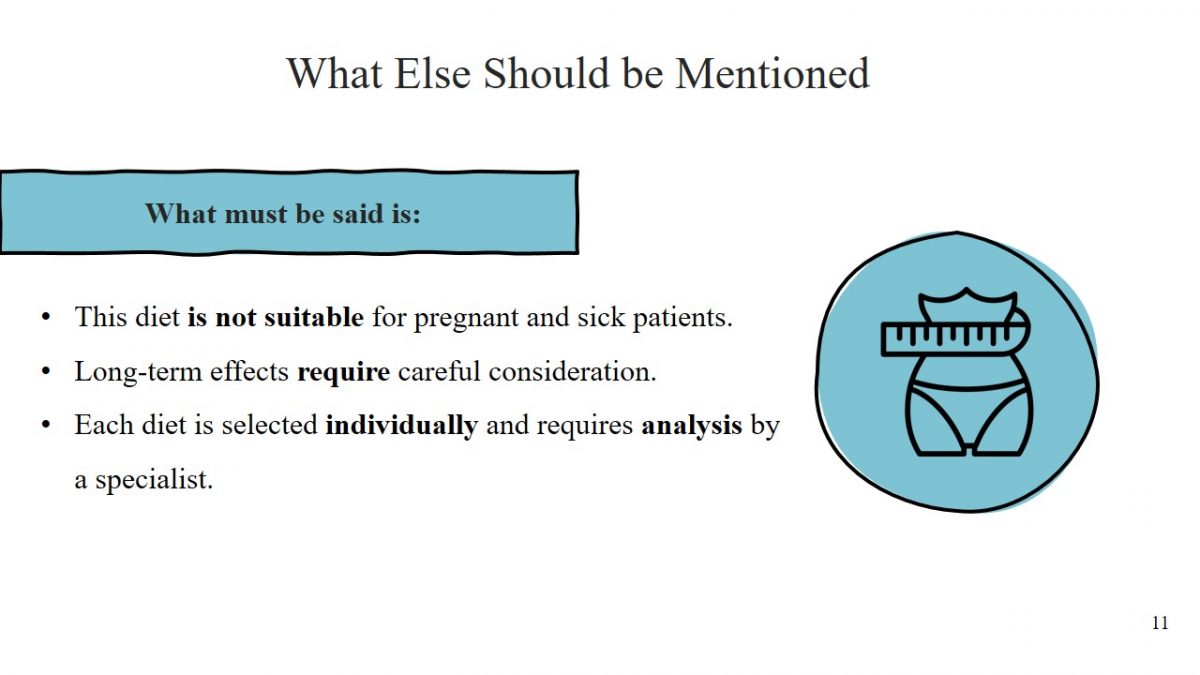
Works Cited
Feldman, Ellen. “Ketogenic Diet for Refractory Pediatric Seizures.” Integrative Medicine Alert, vol. 22, no. 9, 2019, pp. 32-37.
Mawer, Rudy. “10 Graphs That Show the Power of a Ketogenic Diet.” heathline. 2018. Web.
Mawer, Rudy. “The Ketogenic Diet: A Detailed Beginner’s Guide to Keto.” heathline. 2018. Web.
“Pros and Cons of Low-Carb/Ketogenic Diets.” Nutrition Letter, vol. 37, no. 10, 2019, pp. 1-2.
Rho, Jong M. “How Does the Ketogenic Diet Induce Anti-Seizure Effects?” Neuroscience letters, vol. 637, no. 1, 2017, pp. 4-10.
Yancy, William S., Nia S. Mitchell, and Eric C. Westman. “Ketogenic Diet for Obesity and Diabetes.” JAMA Internal Medicine, vol. 179, no. 12, 2019, pp. 1734-1735.
Zajac, Adam, et al. “The Effects of a Ketogenic Diet on Exercise Metabolism and Physical Performance in Off-Road Cyclists.” Nutrients, vol. 6, no. 7, 2014, pp. 2493-2508.